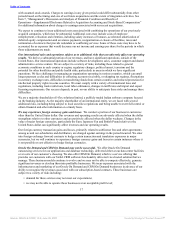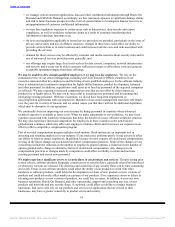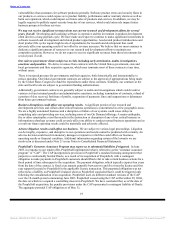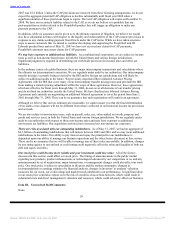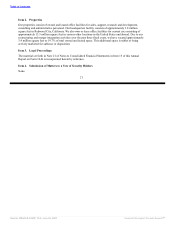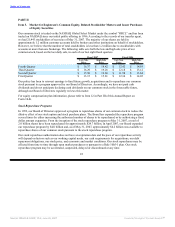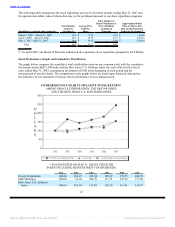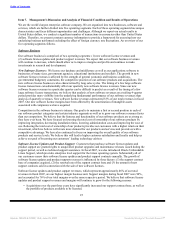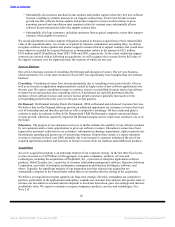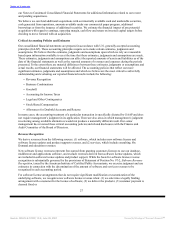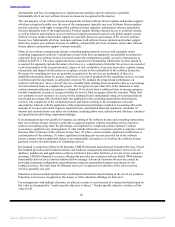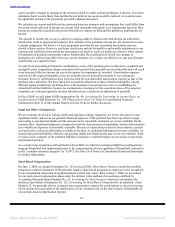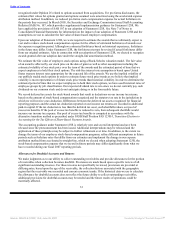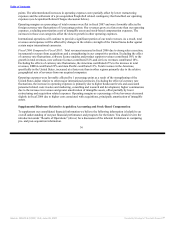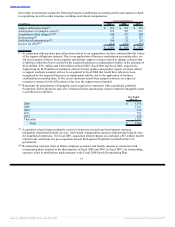Oracle 2006 Annual Report Download - page 31
Download and view the complete annual report
Please find page 31 of the 2006 Oracle annual report below. You can navigate through the pages in the report by either clicking on the pages listed below, or by using the keyword search tool below to find specific information within the annual report.
Table of Contents
our Notes to Condensed Consolidated Financial Statements for additional information related to our recent
and pending acquisitions.
We believe we can fund additional acquisitions with our internally available cash and marketable securities,
cash generated from operations, amounts available under our commercial paper program, additional
borrowings or from the issuance of additional securities. We estimate the financial impact of any potential
acquisition with regard to earnings, operating margin, cash flow and return on invested capital targets before
deciding to move forward with an acquisition.
Critical Accounting Policies and Estimates
Our consolidated financial statements are prepared in accordance with U.S. generally accepted accounting
principles (GAAP). These accounting principles require us to make certain estimates, judgments and
assumptions. We believe that the estimates, judgments and assumptions upon which we rely are reasonable
based upon information available to us at the time that these estimates, judgments and assumptions are made.
These estimates, judgments and assumptions can affect the reported amounts of assets and liabilities as of the
date of the financial statements as well as the reported amounts of revenues and expenses during the periods
presented. To the extent there are material differences between these estimates, judgments or assumptions and
actual results, our financial statements will be affected. The accounting policies that reflect our more
significant estimates, judgments and assumptions and which we believe are the most critical to aid in fully
understanding and evaluating our reported financial results include the following:
• Revenue Recognition
• Business Combinations
• Goodwill
• Accounting for Income Taxes
• Legal and Other Contingencies
• Stock-Based Compensation
• Allowances for Doubtful Accounts and Returns
In many cases, the accounting treatment of a particular transaction is specifically dictated by GAAP and does
not require management’s judgment in its application. There are also areas in which management’s judgment
in selecting among available alternatives would not produce a materially different result. Our senior
management has reviewed these critical accounting policies and related disclosures with the Finance and
Audit Committee of the Board of Directors.
Revenue Recognition
We derive revenues from the following sources: (1) software, which includes new software license and
software license updates and product support revenues, and (2) services, which include consulting, On
Demand and education revenues.
New software license revenues represent fees earned from granting customers licenses to use our database,
middleware and applications software, and exclude revenues derived from software license updates, which
are included in software license updates and product support. While the basis for software license revenue
recognition is substantially governed by the provisions of Statement of Position No. 97-2, Software Revenue
Recognition, issued by the American Institute of Certified Public Accountants, we exercise judgment and use
estimates in connection with the determination of the amount of software and services revenues to be
recognized in each accounting period.
For software license arrangements that do not require significant modification or customization of the
underlying software, we recognize new software license revenue when: (1) we enter into a legally binding
arrangement with a customer for the license of software; (2) we deliver the products; (3) customer payment is
deemed fixed or
27
Source: ORACLE CORP, 10-K, June 29, 2007 Powered by Morningstar® Document Research℠


